About
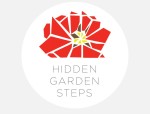 The Hidden Garden Steps project is a volunteer-driven, community-based effort that has created a second set of ceramic-tiled steps and public gardens in San Francisco’s Inner Sunset district while strengthening the existing sense of community that exists here. (The original 16th Avenue Tiled Steps are two very long blocks south of the Hidden Garden Steps, on Moraga Street, between 15th and 16th avenues.) It was completed under the auspices of the San Francisco Parks Alliance and San Francisco Department of Public Works Street Parks Program, and remains a Street Parks Project with Paul Signorelli and Licia Wells serving as site stewards to coordinate the efforts of Friends of the Hidden Garden Steps. New Friends are always welcome to join us in maintaining the site.
The Hidden Garden Steps project is a volunteer-driven, community-based effort that has created a second set of ceramic-tiled steps and public gardens in San Francisco’s Inner Sunset district while strengthening the existing sense of community that exists here. (The original 16th Avenue Tiled Steps are two very long blocks south of the Hidden Garden Steps, on Moraga Street, between 15th and 16th avenues.) It was completed under the auspices of the San Francisco Parks Alliance and San Francisco Department of Public Works Street Parks Program, and remains a Street Parks Project with Paul Signorelli and Licia Wells serving as site stewards to coordinate the efforts of Friends of the Hidden Garden Steps. New Friends are always welcome to join us in maintaining the site.
Project Origins
When Licia Wells and Paul Signorelli joined a friend at the reopening celebration for the Bernal Heights Branch Library in San Francisco on January 30, 2010, they had no idea that they were about to become involved in a neighborhood beautification project in their own neighborhood–the Inner Sunset.
While attending the library event, Licia and Paul met Colette Crutcher, an artist who lives in the Bernal Heights neighborhood, Within a few minutes, the three of them realized they had something in common: the Inner Sunset District’s Tiled Steps project connecting 15th and 16th avenues on Moraga Street. Colette and Aileen Barr had designed and overseen installation of that project; Licia and Paul were among the many admirers of that much-loved neighborhood landmark which attracts visitors from all over the world, so they had one question for Colette: If they could pull together another group of interested neighbors as Alice Xavier and Jessie Audette had done for the Moraga Steps, would she and Aileen be interested in working on a second tiled-steps project near the original site?
Colette, as they learned later, had had conversations like that one many times. Nothing had ever come of them. But this was to be a different set of circumstances, starting with a few Inner Sunset residents who loved the non-tiled steps near their homes and wondered what they could do to stop the vandalism and deterioration that was making them a less-than-inviting walkway.
The thought turned into action a few days later when Licia and Paul saw Liz McLoughlin, who lives at the top of the 16th Avenue steps that connect Kirkham and Lawton streets. Liz and her husband Tom had spent countless hours sweeping debris from the steps and painting over graffiti which continually reappeared on a large wall near the top of the walkway. Liz immediately expressed interest in and enthusiasm for the idea of trying to form an organizing committee that could bring the project to fruition while creating a stronger sense of community within the neighborhood.
With little more than a vague awareness of how Alice and Jessie had ceaselessly worked to lead the Moraga Steps project to fruition—and with a lot of information generously provided by Alice in the early stages of our discussions—Liz and Paul agreed to serve as co-chairs for a new organizing committee. Licia agreed to help coordinate the effort to raise the $300,000 needed to bring the effort to completion and Colette and Aileen started working on designs for what became the Hidden Garden Steps. Licia eventually became the project’s third co-chair.
Building Community Collaborations
The organizing committee continued to grow and meet monthly throughout 2010; the final formal monthly meeting was held in May 2014, five months after the mosaic was installed. (Committee members, at the time of the opening day celebration–December 7, 2013–included Aileen Barr, Ceal Bialobrzeski, Sherry Boschert, Colette Crutcher, Karen Engle, Judy Goddess, Debbie Herzfeld, Cori Holland, Gilbert Johnson, Leena Krasno, Liz McLoughlin, Barbara Meli, Paul Signorelli, Shamsi Soltani, and Licia Wells.) Efforts during the first months of the project were focused on building a project infrastructure–which included establishing a contract to engage the San Francisco Parks Trust as fiscal agent for the project (the Trust later merged with another organization to become the San Francisco Parks Alliance); laying the groundwork for a successful fundraising effort that would begin at the end of 2010; creating awareness and support for the project within the Inner Sunset District; and building relationships with existing groups, including Inner Sunset Park Neighbors; the Golden Gate Heights Neighborhood Association; S.H.A.R.P. (Sunset Heights Association of Responsible People); the Nature in the City Green Hairstreak [Butterfly] Ecosystem Corridor project; the San Francisco Department of Public Works; and DPW’s Street Parks Program. Project volunteers also worked closely with elected officials, including City/County Supervisor Sean Elsbernd, and their staff members; local media representatives; and a variety of groups connected through social media accounts including Facebook and Twitter. Local merchants and vendors also generously supported the project in a number of ways, including free tree-trimming services (to clean up decades of neglect) and public receptions to draw attention to the project.
Project Successes
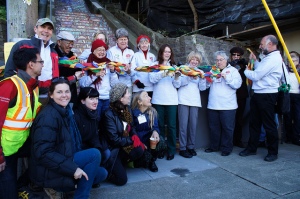
Opening-day ribbon-cutting, with organizing committee members and other project partners; photo by Steve Bowles/San Francisco Parks Alliiance
By the time the completed mosaic was installed in November 2013, donors had contributed more than $216,000 in cash to support the project; DPW completed major structural repairs valued at approximately $250,000 to replace a broken retaining wall and an entire flight of steps that were badly out of alignment with the rest of the structure, and produced the magnificent erosion-control terracing the serves as the foundations for the gardens being installed on either side of the mosaic; and volunteers had donated hundreds of hours of services ranging from website design and management; marketing and PR, fundraising, and onsite clean-up and planting. Nature in the City has provided more than $1,000 in native plants for the onsite gardens. Students at Woodside International School painted the fundraising mural that was in place at the foot of the Steps (at Kirkham Street and 16th Avenue) until shortly before the opening-day celebration on December 7, 2013. Supervisor Sean Elsbernd used funds from a neighborhood beautification account to pay the more than $7,000 in permit application fees that needed to be covered so the project could proceed. Our colleagues in Inner Sunset Park Neighbors have strongly supported our efforts by including us in on street fairs and other neighborhood gatherings. And SF Weekly named the project “Best Community Art” in 2011.
Installation of the mosaic brought the first huge phase of the project to completion. The second, long-term phase is to continue supporting the Steps as a neighborhood gem that serves as a place where people from our world-wide community of support can meet, eat, talk, and dream together about how we can continue collaborating to maintain the sense of collaboration that makes the Inner Sunset District a vital and vibrant part of San Francisco.
Recognition
Accolades from our extended community of peers came early, with SF Weekly calling the Hidden Garden Steps “Best Community Art” project in its 2011 “Best of” issue–long before the first tile had been created by the project artists. Installation of the mosaic and gardens was followed, in April 2014, with a “Street Park of the Month” designation in Street Wise, the San Francisco Department of Public Works and San Francisco Parks Alliance (SFPA) newsletter for Street Park stewards and their neighbor groups. Aileen Barr was invited to travel to Las Vegas to attend the Coverings 2014 international trade fair and expo that is dedicated exclusively to showcasing the newest in ceramic tile and natural stone; she and Colette Crutcher were honored, at the conference, with the 2014 Coverings Installation & Design (CID) Award for best community project for their design and fabrication of the 148-step ceramic-tile Hidden Garden Steps mosaic.
The artists and project volunteers have continued to receive invitations to discuss the project in a variety of settings. Project representatives were among the featured speakers at Street Parks Project workshops in 2012, 2013, and 2014, and have made formal presentations at local libraries to guide other community members interested in successfully developing community collaborations and formal partnerships. Aileen Barr and Paul Signorelli also accepted an invitation to lead a plenary session at the 15th Biennial Community Built Association Conference (held in Davis, CA in April 2014).
Next Steps
Members of the original organizing committee voted in May 2014 to officially change the name of the project–still under the auspices of the San Francisco Park Alliance and San Francisco Department of Public Works Street Parks Program–to ‘Friends of the Hidden Garden Steps,” an informal and ever-growing group of volunteers willing to help maintain the site.
Please join the Friends at our monthly clean-ups (second Saturday of each month, from 1-3 pm) or contact us at hiddengardensteps@gmail.com for more information about how to be part of the Steps community.
All of us involved in the project look forward to seeing you on the Steps.
***
More extensive coverage is available on the Hidden Garden Steps website (which includes numerous links to our social media sites, at the bottom of the home page); through our project newsletter; on Scoop.it!; and on the Building Creative Bridges blog. Numerous photographs detailing various project achievements are also online and available, under a Creative Commons License, for noncommercial use.
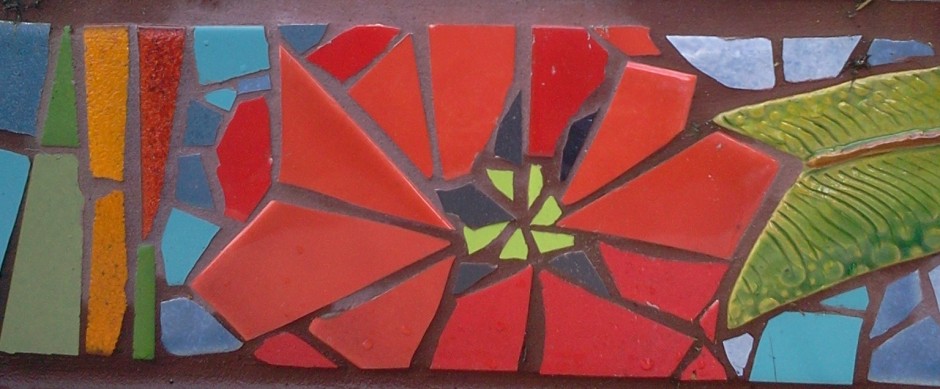

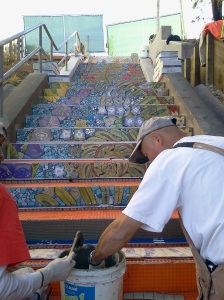
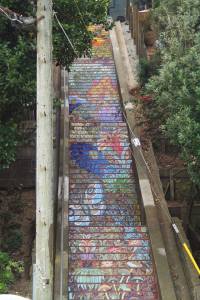
Recent Comments